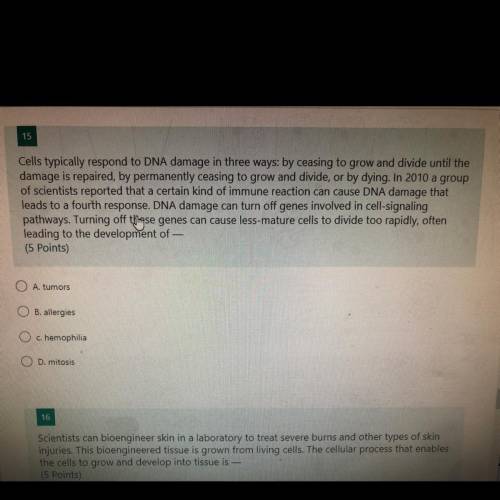
Biology, 28.10.2020 18:50 naomicervero
Cells typically respond to DNA damage in three ways: by ceasing to grow and divide until the
damage is repaired, by permanently ceasing to grow and divide, or by dying. In 2010 a group
of scientists reported that a certain kind of immune reaction can cause DNA damage that
leads to a fourth response. DNA damage can turn off genes involved in cell-signaling
pathways. Turning off these genes can cause less-mature cells to divide too rapidly, often
leading to the development of


Answers: 2


Another question on Biology

Biology, 21.06.2019 14:40
Select all the correct answers. which statements fail to meet the requirements of a scientific claim? 1 even though evidence indicates that the solar system's planets follow elliptical paths, copernicus's model involving circular orbits is true. 2 the evidence supporting newton's laws of motion was accurate in newton's time, but the universe operates differently today. 3 flowers that reflect the most ultraviolet light are more likely to attract bees and other pollinators than flowers that reflect less ultraviolet light. 4 in the final 100 meters of a 10,000-meter race, an athlete's speed is more strongly related to anaerobic efficiency than to aerobic efficiency.
Answers: 2

Biology, 21.06.2019 21:50
Imagine a rocket launching from earth and travelling to the moon. in which order would the rocket pass through the layers of the atmosphere? thermosphere, mesosphere, stratosphere, troposphere troposphere, mesosphere, stratosphere, troposphere thermosphere, stratosphere, mesosphere, troposphere troposphere, stratosphere, mesosphere, thermosphere
Answers: 2


Biology, 22.06.2019 07:00
Which best describes the nucleus of an atom a. it is where all of the particle s of the atom are located b. it is the negatively charged part of the atom c. it is where the electrons and the protons are located d. it is the part of the atom with the greatest mass
Answers: 2
You know the right answer?
Cells typically respond to DNA damage in three ways: by ceasing to grow and divide until the
damage...
Questions


French, 13.11.2019 23:31




Mathematics, 13.11.2019 23:31

Mathematics, 13.11.2019 23:31

Mathematics, 13.11.2019 23:31


History, 13.11.2019 23:31

Mathematics, 13.11.2019 23:31

Mathematics, 13.11.2019 23:31

Mathematics, 13.11.2019 23:31

Advanced Placement (AP), 13.11.2019 23:31

Mathematics, 13.11.2019 23:31


Mathematics, 13.11.2019 23:31



Law, 13.11.2019 23:31



